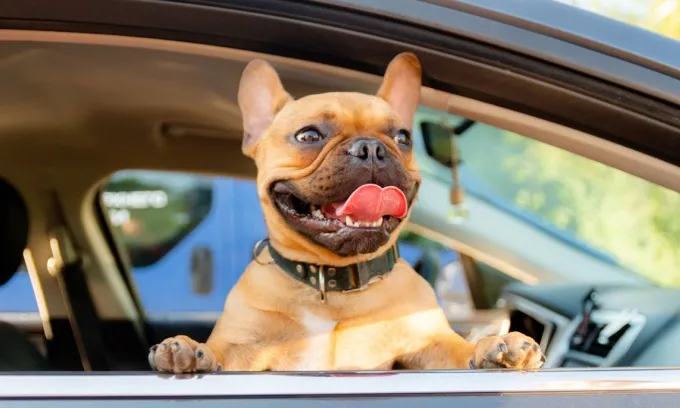If you’re a dog person, then you probably don’t like being separated from your furry friend for too long, but sometimes work necessitates it. You may be happy to leave your dogs at home through the workday, but this isn’t always an option, and an anxious dog can do big damage around the house.
Bree Robbins, the owner of Brisbane doggy daycare Paddington Pups, told Canstar that the damage bill from an anxious dog can be hefty. “I’ve had customers who are bringing their dogs into daycare five days a week, [saying] doggy daycare is way cheaper than the $50,000 worth of damage that their dog has done at home,” she said.
If you’re considering sending your pup to a daycare, you probably have a lot of questions, starting with price.
How much does doggy daycare cost?
Doggy daycare costs can vary, but based on a survey of advertised doggy daycare prices in capital cities, you might expect prices to start at around $60 to $65 per day for a standard doggy daycare session.
Some doggy daycare centres offer trial days, starting from around $45, and many offer discounts for buying in bulk, with rates getting cheaper the more sessions you purchase. Some may also offer half-day rates, with prices starting at around $48.
Some doggy daycares charge a standard rate no matter the size of the dog, but some charge by the size of the dog. For instance, one doggy daycare in central Sydney charges a standard daily rate ranging from $74 for a small dog to $94 for an extra large one.
Some doggy daycare facilities offer additional services, ranging from pickup and dropoff through to grooming, nail clipping and bathing. These additions can start from $30 and go up from there, depending on the particular doggy daycare and the service.
Why does doggy daycare cost so much?
Tegan Bensley, the owner of Brisbane-based centre Paws and Relax, told Canstar that the price of doggy daycare takes into account the fact that it is a high-staffed industry, so these costs can be necessary to ensure there is an appropriate ratio of staff to dogs, and that the facility is appropriately cleaned and resourced and run to a high standard.
“There are backyard daycares that charge a lot less but they have a lot less to offer,” she said. “We have a lot of extra programs and do a lot of in-house training, for example.” She added that some “more expensive” daycares will have programs for rehab and socialisation for anxious dogs.
How many days a week is ideal for doggy daycare?
The answer to how many days a week of doggy daycare is appropriate will depend on a number of factors, including your dog’s age and energy level and tolerance for socialising, as well as your budget. For many, two days a week may be the sweet spot.
“Most of our clients do about two to three days a week,” said Ms Bensley. “If they send them too often, the dogs get overwhelmed and overtired, and less can mean they’re not settling in well with the rest of their friends, or getting a bit of a shock to the system every time.”
Ms Robbins said that a daycare session can be like “Disneyland” for pups, with lots of sights and sounds and smells and stimulation, but that it can be tiring. She told Canstar that “unless you’ve got a really high-energy breed of dog or an adolescent puppy” that you’re trying to train, twice a week is a good amount of time.
What are the advantages and disadvantages of doggy daycare?
There are a number of positive things your dog might get out of the doggy daycare experience. For example:
- The ability to socialise with other dogs and burn off energy
- The opportunity to be stimulated and entertained rather than being bored at home
- The chance to enjoy play facilities and human interaction
There are also some advantages for you, for example:
- The peace of mind of knowing that your dog can be taken care of through the day
- The possibility to curb destructive behaviour at home by ensuring your dog is appropriately stimulated and burns off excess energy
That said, there can also be some disadvantages to doggy daycare, for example:
- A noisy and crowded environment can be overwhelming for some dogs
- If your doggy daycare is not appropriately staffed, then the level of supervision for your dog could be low
- While doggy daycare facilities typically require vaccinations, there can still be health and hygiene concerns and a risk of kennel cough or fleas
- For many, one of the biggest downsides to doggy daycare may be the expense. If your facility charges $60 per session, then five days a week could cost up to $300, depending on any bulk discounts on offer.
For this reason, among others, many owners may choose to use doggy daycare for one or two days a week, to give their pup some stimulation and a change of scene during the work week.
What should you look out for in a doggy daycare?
So, when it comes to choosing a doggy daycare, how do you know if you’re onto a good one? Ms Bensley told Canstar that every facility has a specialty, so owners should consider what they want for their dogs.
“Do you want your dog to just go and play for the day?” she said. “Do you need rehab daycare? Does your dog do better in a big open space where they can play outside, or are they going to do okay in an indoor facility? All these things need to be considered before even looking.”
There are some specific things to look out for when choosing the right facility, to make sure your dog will be safe, secure and supervised. According to the experts we spoke to, these important things include:
A good dog-to-staff ratio
When choosing a doggy daycare, it is important to consider the number of staff who’ll be there to make sure your pooch doesn’t get lost in the pack. “Do they have 50 dogs to one staff member?” asked Ms Bensley, noting that she typically has one staff member to look after every 10-12 dogs. “You need to ask if the dogs are supervised during play,” she added. The more staff there are at a facility, the more likely it is that your dog will get the attention and supervision it needs through the day, and that any incidents or injuries will be spotted quickly.
Staff who are trained in pet first aid
The last thing you want is for your dog to get sick or injured at daycare, but these things can happen, so it’s vital for the staff of any facility to be trained in pet first aid. “My team has picked up on ticks, they’ve saved dogs’ lives,” said Ms Robbins. “They’ve called owners because their elderly dogs are deteriorating. I’ve seen hip dysplasia. I’ve noticed dogs not walking right and informed the owners they need to go to the vet because the dog is having issues.”
Well-trained staff who spend all day around dogs may be able to notice things an untrained owner might not. “I’ve seen dogs that are just quieter than usual, and told the owners to go to the vet,” said Ms Robbins. “We’ve found dogs that have lupus or ear infections. Working in this industry, we’re able to see issues with your dogs that you might not. We’re watching them from 10 to 12 hours a day, so we’re able to pick up on little behaviours that you might not necessarily see.”
A high standard of cleanliness
Ms Robbins told Canstar that cleanliness is vital. “You want a facility where anything that they’re using can be sterilised and cleaned, that’s really important,” she said. “You don’t want too many plush fabrics, because dogs will be dogs, they’re going to want to pee on stuff and chew stuff.” She also said that some facilities have fake grass inside, which can look nice, but with dozens of dogs potentially peeing on it all day, it can be difficult to clean properly.
Safe dog toys
It’s also important to ask whether the toys your facility is using are safe for dogs, and to be wary of small toys in a doggy daycare environment. “I can have toys for my dogs at home that are small and that I know that they won’t swallow and chew because of the way that I play,” Ms Robbins said. “But as soon as you introduce a whole bunch of other dogs, your dog’s going to play and behave differently. Your dog might get possessive of the toy and say ‘no, that’s mine’, and run away with it and end up swallowing or choking on it.”
A good reputation
When trying to choose a doggy daycare, Ms Robbins suggested it’s also important to consider how long the facility has been around. “I think reputation matters,” she said. “I think how long you’ve been around in the industry really actually matters. There are a lot of fly-by-night daycares that I’ve seen come up. I’ve been in the industry for years now, and I’ve seen a lot of daycares open and then close again. It’s a lot harder than people think it is to run, from a business perspective,” she said, adding that the job is a lot more than just “smushing” cute dogs all day.
Do dogs like going to doggy daycare?
While many dogs like the opportunity to socialise with other pups and burn off energy, some may experience anxiety or feel overwhelmed in the presence of too many others. This may especially be the case if your pup was not socialised with other dogs at a young age and has not learned to play and interact with them.
It should be relatively easy to work out if your dog is enjoying the doggy daycare experience. If they wag their tail in the morning and seem excited to go, and greet the staff with enthusiasm at the door, then these are generally telltale signs that they are excited for the day ahead.
How can you tell, though, if your dog’s not having a good time? While you can ask the staff for direct feedback, Happy Hound University has a list of telltale signs you can look out for to see whether your dog is enjoying the doggy daycare experience. For example:
- If your dog is not eager to enter the building and tries to pull away, or walks with a lowered tail carriage or body posture when approaching, this is a sign that they may be fearful.
- If staff describe your dog as “shy” or note that it prefers hanging out with humans to other dogs, this may also be a sign that it does not enjoy socialising at doggy daycare.
If your doggy daycare has cameras and you are able to view footage of your pup during the day, there are also some telltale signs you can look out for to help you get a picture of whether they’re having a hard time. For example:
- If your dog has to be ‘bullied’ into play by other dogs barking at it, or if your dog does not solicit play from other dogs, this is a sign that it may not be enjoying the experience of socialising at doggy daycare.
- If your dog often spends time up against the wall or in corners, rather than seeking out other dogs, this is a sign that it may be nervous and survival instincts may be kicking in.
What are some alternatives to doggy daycare?
If you don’t feel that doggy daycare is suitable for you and your pup, but you need someone to keep an eye on them through the day, there are a number of other options you can consider. Services like Mad Paws or Paw Shake offer a range of options, from dog-walking to in-home pet sitting, where a verified member will call in to check on your pooch during the workday. Likewise, you can ask a friend or family member to pet-sit for you a few times a week, although if your dog needs supervision, it may be worth keeping a local doggy daycare in mind, in case plans with family or friends happen to fall through.
Whatever option you choose, when you have a dog, you have a little furry friend who loves and depends on you, so it’s important to do your research when deciding what works best for you and for them.
Cover image source: Alexandr Khakhlin/Shutterstock.com








